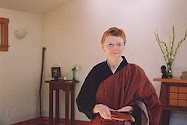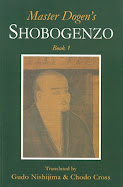 A bodhi tree bonsai. Can you imagine it?! You can find it here.
A bodhi tree bonsai. Can you imagine it?! You can find it here.Another question posed this week has got me thinking about providing a broader introduction to different types of Zen.
As I've mentioned, Zen is really just the Japanese pronunciation of Ch'an, which is the Chinese pronunciation of Dhyana, the Sanskrit word for meditate. And this short lesson in etymology pretty much follows the path that Zen as we know it took from India to Japan, with a few stops in-between. An excellent source for the history of that pathway--with lots of links to lots more information-- can be found at this Wikipedia page and also in this article at DharmaNet (which I found here, on their "Brief History of Buddhism" page).
Today I thought I'd post some resources that provide a glimpse into the other types or schools of Zen Buddhism. This will be a very generalized list; as you surf along, you're sure to find more categories and sub-categories that provide a richer picture of each school and possibly related schools.
For now, we'll start with China, which is where Soto Zen legend has it that Bodhidharma traveled from India to offer Buddhism to the Emperor. He was refused, and so he sat in meditation facing the wall of a cave for 9 years before emerging again.
A resource for Ch'an Buddhism in America is Dharma Drum Mountain. You can read their take on the history of Ch'an Buddhism here. (Bear in mind that there are many, many schools in the Chinese Buddhist tradition. This will just get you started!)
From China, Ch'an Buddhism spread into the neighboring country of Korea. The best resource that I know of to learn more about Korean Zen in America is The Kwan Um School of Zen, founded by Zen Master Seung Sahn.
Zen also flourished in Vietnam, becoming a lovely blend of Ch'an, Pure Land and Theravadin Buddhist tradition (there's an informative read about the history here). Thich Nhat Hanh, one of the most beloved Buddhist teachers in the West, is one of the most accessible resources for Westerners.
Zen arrived in Japan by way of China and Korea in the early 13th century. Today the most (popularly) recognized schools of Japanese Zen are that of Rinzai and my tradition, Soto. Rinzai Zen has a focus on sharpening the mind's concentration with koan practice, while Soto Zen emphasizes zazen meditation or shikantaza, "just sitting". Mind you, these two paths do meet and in fact intertwine in some lineages, and there is a great and spirited debate among scholars and practitioners alike of just how different or similar these schools are or aren't.
Find out for yourself by starting with these earliest Japanese Zen masters who founded temples and zen centers all across America:
Shunryu Suzuki: Soto Zen; San Francisco Zen Center
Hakuyu Taizan Maezumi: Rinzai, Soto & Harada-Yasutani lineages; Los Angeles Zen Center
and the White Plum Asanga
Taisen Deshimaru: Soto; American Zen Association (New Orleans)
Soyu Matsuoka: Soto
Kyozan Joshu Sasaki: Rinzai; Mt Baldy Zen Center, CA (interesting to note that one of his more famous students is Leonard Cohen!)
Eido Shimano: Rinzai; Dai Bosatsu Zendo, New York State
Soen Nakagawa: Rinzai, founded Dai Bosatsu with Shimano Roshi.
Sokei-an Shigetsu Sasaki: Rinzai; First Zen Institute of America, NYC (interesting to note, he was one of the first Zen Masters to arrive in America; his most famous student was Alan Watts.)
I'll be writing a bit more about lineages and teachers in general, but for now, this short list forms the basis of what we know today as American Zen.
By all means, if you have an interesting link or further suggestions for this very basic outline of the many types of Zen that exist in the world, please share it in the comment section. Know too that I'm plotting a two-part post about teachers and lineages for the future, and comments or suggestions to that end are welcome also.
Enjoy the many, many flavors!









